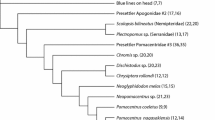Summary
Patterns of prey size selectivity were quantified in the field for two species of marine microcarnivorous fish, Embiotoca jacksoni and Embiotoca lateralis (Embiotocidae) to test Scott and Murdoch's (1983) size spectrum hypothesis. Two mechanisms accounted for observed selectivity: the relative size of a fish in relation to its prey, and the type of foraging behavior used. Juvenile E. jacksoni were gape limited and newborn individuals achieved highest selectivity for the smallest prey size by using a visual picking foraging strategy. As young E. jacksoni grew, highest preference shifted to the next larger prey sizes. When E. jacksoni reached adulthood, the principal mode of foraging changed from visual picking to relatively indiscriminant winnowing behavior. The shift in foraging behavior by adults was accompanied by a decline in overall preference for prey size; sizes were taken nearly in proportion to their relative abundance. Adult E. lateralis retained a visual picking strategy and achieved highest selectivity for the largest class of prey. These differences in selectivity patterns by adult fish were not explained by gape-limination since adults of both species could ingest the largest prey items available to them. These results support Scott and Murdoch's (1983) hypothesis that the qualitative pattern of size selectivity depends largely on the range of available prey sizes relative to that a predator can effectively harvest.
Similar content being viewed by others
References
Allan JD (1978) Trout predation and the size composition of stream drift. Limnol Oceanogr 23:1231–1237
Baltz DM (in press) Life history variation in the surfperch family (Perciformes: Embiotocidae). Env Biol Fish
Bence JR, Murdoch, WW (in prep) Mechanisms of prey size selection by mosquitofish
Brooks JL (1968) The effects of prey size selection by lake planktivores. Syst Zool 17:272–291
Brooks JL, Dodson SI (1965) Predation, body size, and composition of plankton. Science 150:28–35
Chesson J (1978) Measuring preference in selective predation. Ecology 59:211–215
Chesson J (1983) The estimation and analysis of preference and its relationship to foraging models. Ecology 64:1297–1304
Coyer JA (1979) The invertebrate assemblage associated with Macrocystis pyrifera and its utilization as a food source by Kelp forest fishes. PhD dissertation. Univ So Cal p 364
DeMartini EE (1969) A correlative study of the ecology and comparative feeding mechanism morphology of the Embiotocidae (surf-fishes) as evidence of the family's adaptive radiation into available ecological niches. Wasmann J Biol, Univ San Francisco 27:177–247
Drenner RW, deNoyelles, Jr F, Kettle, D (1982) Selective impact of filter-feeding gizzard shad on zooplankton community structure. Limnol Oceanogr 27:965–968
Ebeling AW, Bray RN (1976) Day versus night activity of reef fishes in a Kelp forest off Santa Barbara, California. Fish Bull, US 74:703–717
Galbraith Jr MG (1967) Size-selective predation on Daphnia by rainbow trout and yellow perch. Trans Am Fish Soc 96:1–10
Gillian AL, Stein RA, Carline RT (1981) Predation by pellet-reared tiger muskellunge on minnows and bluegills in experimental systems. Trans Am Fish Soc 110:197–209
Hall DJ, Cooper WE, Werner EE (1970) An experimental approach to the production dynamics and structure of freshwater animal communities. Limnol Oceanogr 15:829–928
Hansen MJ, Wahl DH (1981) Selection of small Daphnia pulex by Yellow Perch fry in Oneida Lake, New York. Trans Am Fish Soc 110:64–71
Hartman GF (1958) Mouth size and food size in young Rainbow Trout, Salmo gairdneri. Copeia 1958:233–234
Hixon MA (1979) Competitive interactions and spatiotemporal patterns among California reef fishes of the genus Embiotoca. PhD dissertation UC Santa Barbara p 213
Holbrook SJ, Schmitt RJ (in press) Experimental analyses of patch selection by foraging black surfperch (Embiotoca jacksoni). J Exp Mar Biol Ecol
Isaacson PA, Isaacson DM (1966) Notes on the life history of the black perch, Embiotoca jacksoni, Agassiz. Trans Am Fish Soc 95:107–109
Kislalioglu M, Gibson RN (1976a) Prey “handling time” and its importance in food selection by the 15-spined stickleback, Spinachia spinachia (L.). J Exp Mar Biol Ecol 25:151–158
Kislalioglu M, Gibson RN (1976b) Some factors governing prey selection by the 15-spined stickleback, Spinachia spinachia (L.). J Exp Mar Biol Ecol 25:159–169
Knights B (1983) Food particle-size preferences and feeding behaviour in warm-water aquaculture of European Eel, Anguilla anguilla (L.). Aquaculture 30:173–190
Laur DR, Ebeling AW (1983) Predator-prey relationships in a guild of surfperches. Env Biol Fish 8:217–229
Lawrence JM (1957) Estimated sizes of various forage fishes largemouth bass can swallow. Proc SE Assoc Game and Fish Comm 11:220–226
Manly BFJ (1974) A model for certain types of selection experiments. Biometrics 30:281–294
Schmitt RJ, Coyer JA (1982) The foraging ecology of sympatric marine fish in the genus Embiotoca (Embiotocidae): importance of foraging behavior in prey size selection. Oecologia (Berlin) 55:369–378
Schmitt RJ, Coyer JA (1983) Variation in surfperch diets between allopatry and sympatry: circumstantial evidence for competition. Oecologia (Berlin) 58:402–410
Schmitt RJ, Holbrook SJ (1984) Ontogeny of prey selection by black surfperch, Embiotoca jacksoni (Pisces: Embiotocidae): the roles of fish morphology, foraging behavior, and patch selection. Mar Ecol Prog Ser (in press)
Scott MA, Murdoch WW (1983) Selective predation by the backswimmer, Notonecta. Limnol Oceanogr 28:352–366
Werner EE (1977) Species packing and niche complementarity in three sunfishes. Am Nat 111:553–578
Werner EE, Hall DJ (1974) Optimal foraging and the size selection of prey by the bluegill sunfish (Lepomis macrochirus). Ecology 55:1042–1052
Zaret TM (1980) Predation and freshwater communities. New Haven: Yale Univ Press p 187
Author information
Authors and Affiliations
Rights and permissions
About this article
Cite this article
Schmitt, R.J., Holbrook, S.J. Gape-limitation, foraging tactics and prey size selectivity of two microcarnivorous species of fish. Oecologia 63, 6–12 (1984). https://doi.org/10.1007/BF00379778
Received:
Issue Date:
DOI: https://doi.org/10.1007/BF00379778




